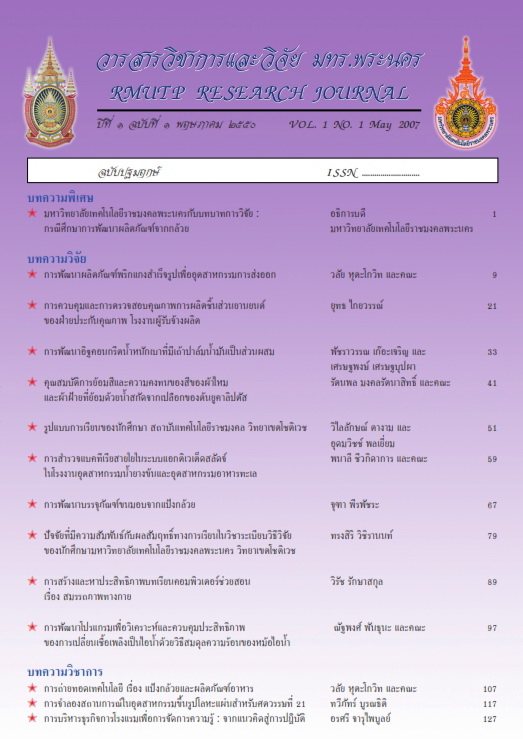รูปแบบการเรียนของนักศึกษา สถาบันเทคโนโลยีราชมงคล วิทยาเขตโชติเวช
Main Article Content
บทคัดย่อ
บทคัดย่อ
การวิจัยนี้ศึกษาและเพื่อเปรียบเทียบรูปแบบการเรียนของนักศึกษาคณะวิชาคหกรรมศาสตร์ สถาบัน เทคโนโลยีราชมงคลวิทยาเขตโชติเวช จำแนกตาม เพศ สาขาวิชา และระดับชั้นปี กลุ่มตัวอย่างคือนักศึกษาจำนวน 249 คนเครื่องมือที่ใช้เป็นแบบมาตราส่วนประมาณค่า 5 ระดับ เกี่ยวกับรูปแบบการเรียน 6 รูปแบบ ของ Grasha และ Reichman คือ แบบอิสระ แบบพึ่งพา แบบหลีกเลี่ยง แบบร่วมมือ แบบมีส่วนร่วม และแบบแข่งขัน จำนวน 60 ข้อ มีค่าความเชื่อมั่นเท่ากับ 0.71 วิเคราะห์ข้อมูลด้วยโปรแกรม SPSS for Windows สถิติที่ใช้คือ ค่าร้อยละ ค่าเฉลี่ย ค่าส่วนเบี่ยงเบนมาตรฐาน t-Test One-Way ANOVA และ Tukey HSD ผลการวิจัยพบว่า นักศึกษามีรูปแบบการเรียนแบบมีส่วนร่วมและแบบร่วมมืออยู่ในระดับสูง รองลงมาคือ แบบพึ่งพา แบบอิสระ แบบแข่งขัน และแบบหลีกเลี่ยง ตามลำดับ นักศึกษาเพศชายกับเพศหญิงมีรูปแบบการเรียนแตกต่างกันรูปแบบเดียวคือ แบบหลีกเลี่ยง นักศึกษาสาขาวิชาต่างกันมีระดับรูปแบบการเรียนแตกต่างกัน 3 รูปแบบคือ แบบพึ่งพา แบบร่วมมือ และแบบแข่งขัน นักศึกษาระดับชั้นปีต่างกัน มีรูปแบบการเรียนแตกต่างกันรูปแบบเดียวคือ แบบร่วมมือ
Abstract
The research was to study and compare learning styles of students of the faculty of Home Economics, RIT Chotiwet Campus deviding into sex, department and level of education. The sample consisted of 249 students in the second semester of academic year 2003. The 5 rating scale questionnaire consisted of 6 learning styles classified by Reichman and Grasha : Independent, Dependent, Avoidance, Collaborative, Participant and Competitive, consisting of 60 items. The reliability was 0.71. The data were analyzed by using SPSS for window. The statistics used were percentage, mean, standard deviation, t-Test, One -Way ANOVA and Tukey HSD.
The results were as follows: 1. Most students occupied collaborative and participant learning styles, then dependent, independent, competitive and avoidance respectively. 2. There was only one difference between male and female students learning styles that was avoidance. 3. Students from different majors had 3 different learning styles which were dependent, collaborative and competitive. 4. Students who were in different levels of study had 1 different learning style which was collaborative.


